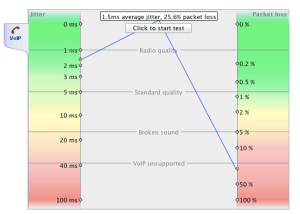5 Reasons Your VoIP Isn’t Working – Improving Your VoIP Call Quality
If you’re using a VoIP phone system, chances are you have experienced poor call quality in some shape or form. But whether you struggle with latency or jitter, the good news is that most VoIP call quality problems are easy to solve. We’ll discuss what causes these issues so that you can enjoy crystal clear call quality 24/7.
The Five Causes of Poor VoIP Call Quality
You’ve probably heard telecommunications professionals toss around terms like “jitter,” “latency,” and “packet loss” when they talk about poor VoIP call quality. But if you’re like most customers, you’re probably not clear on what these terms mean or how they affect the call quality that you experience on a VoIP phone system.
In this quick and handy reference guide, we’ll define these common problems with VoIP call quality, and discuss some of the most common causes for these issues.
Let’s get started at looking at the five specific causes that you need to check first.
Diagnosing Problems with VoIP Call Quality
1. Poor Internet Connection
Because VoIP relies on your Internet connection to deliver and receive the voice packets that make up a call, the speed of your Internet connection is crucial. Internet connections with low-bandwidth limit your VoIP call quality directly. If you’re using an antiquated dial-up connection or even a USB wireless modem with limited internet connection speed, you can expect your VoIP call quality to be less than spectacular.
A slow or unstable internet connection can cause latency and jitter during VoIP calls.
Jitter is literally the variation in the time it takes packets to travel through the Internet (latency) from your softphone or VoIP device to the party you called. Excessive latency and jitter cause a high rate of packet loss, and can cause echo and sub-par sound quality.
2. Saturated Internet Connection
Think of Internet saturation as the over-sharing of available bandwidth. Saturation reduces the bandwidth available for each call, and can lead to reduced call quality. The saturation can occur on your own laptop, on your LAN, or at your router, whether you’re at the office or at home.
Do you know how many applications or services you have running on your computer right now? Even if you’re not currently using a specific application, like Microsoft Office or Adobe Photoshop, they’re still using your bandwidth and therefore could be affecting your VoIP call quality. In fact, many laptop services run in the background and use your Internet connection.
How many people in your household or office are using your Internet connection? Do you know how many applications or services they have running? Each user probably has as many services using the Internet as you do. The more users you have in your work group, company, or household, the more saturated your connection will be.
Now, let’s branch out a little further and think about how many people live in your neighborhood or work in your office building. If your Internet travels through cable, fiber optic cable or copper, then you’re all sharing the same Internet connection.
3. Internet Congestion From Your VoIP Provider
Your VoIP service provider plays a large role in your VoIP call quality, which is why it’s important to choose a respectable provider (see no. 4 below). It may appear that you have plenty of bandwidth, but if the quality of the provider’s network is poor, then you’re going to have VoIP problems.
A poor VoIP service provider network can introduce latency, delay, and packet dropouts into your calls. While your connection speed may look great and work well for large file download, latency and jitter that don’t affect big FTP transfers make a mess out of VoIP calls. Problems may vary with time, that is, over the course of a work day. This can vary with the amount of traffic handled by the service provider.
4. Your Internet Provider is Unreliable
Your parents probably warned you about taking candy from strangers, right? Well, change “candy” to “Internet” and the same warning can be applied when signing up with an Internet service provider. There are many “fly by night” internet providers who claim to have high-speed connections at a low-cost, when in reality they don’t have the capacity to deliver such services.
We’re not saying that you have to go with a large provider, but we do suggest thoroughly researching your options before making a decision. Read customer reviews to get an idea of their service and how they treat their customers.

You can use VoIP Connection Testing to Assess and Predict the VoIP Call Quality You Can Expect from Your VoIP Service Provider
If you’re still not sure that you’ve found a reliable Internet service provider, get a trial and test your connection with a reliable service such as www.speedtest.net for overall network performance, and a VoIP test such as http://www.onsip.com/tools/voip-test to check factors affecting your VoIP call quality.
For really good VoIP call quality, you should see jitter at about 1 ms (milliseconds) or 2 ms, or less, and packet loss should be 0.0%. For “acceptable” call quality, your jitter can be as large as 7 ms and packet loss can reach 1%.
5. Insufficient Equipment
Outdated routers, firewalls, and cable modems can also contribute to poor VoIP call quality. If you are experiencing poor call quality, you should either update your router software or replace with new equipment. You can examine each network element between your laptop or VoIP device and the internet to isolate older components that can be updated or replaced.
Remember: you can work with your VoIP service provider to help isolate and identify the cause of poor VoIP call quality problems you experience and fix them in a timely manner. If you’re having recurring VoIP call quality issues, you may want to consider switching to another VoIP service provider.

[…] 5 Reasons Your VoIP Isn’t Working – Improving Your VoIP Call Quality […]